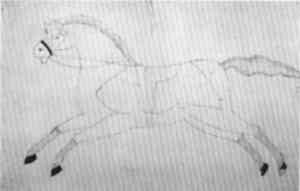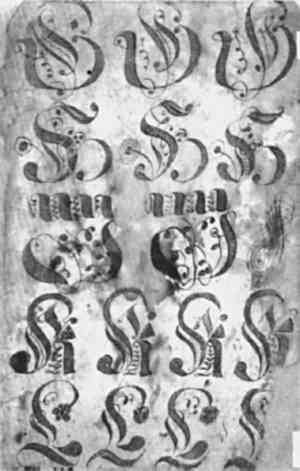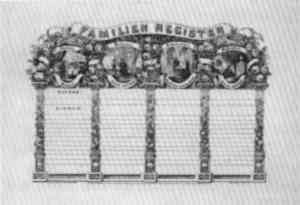THE FRAKTUR: ITS HISTORY AND A CONSERVATION CASE STUDYTED STANLEY
2 HISTORY OF THE FRAKTUR IN PENNSYLVANIA2.1 IMMIGRATION
Fraktur-schrift, or “fraktur writing,” is a decorative calligraphy named after a 15th-century typeface called Fraktur (Lichten 1958). Fraktur lettering of the text and designs surrounding or embellishing the text are the two main elements of the fraktur. Religious hymns and scripture are sometimes contained in the text, but other types of frakturs were also produced. Some of these frakturs had very little text or sometimes
The majority of frakturs in America date from about 1750 to 1860. They were at the peak of their popularity from 1800 to 1835. Frakturs were produced by Protestant groups from the Rhineland, Switzerland, and the surrounding regions who immigrated to the American colonies in the late 17th century seeking religious freedom. Many were Lutherans or members of Reform churches, but others were Moravians, Mennonites, Dunkers, Schwenkfelders, and Amish. The various groups settled along the Atlantic coast from Ontario to the Carolinas. They also pushed westward to the Ohio Valley. Protestant German immigrants settled Germantown, Pennsylvania, in 1683 and across southeastern Pennsylvania. They brought with them a strong cultural fervor that is reflected in their use of the fraktur. Several distinct members of the Pennsylvania German community were active in producing frakturs. Ministers of the church made fraktur documents such as the Taufschein (birth or baptismal certificate), the Geburts (an early birth certificate form), the Traufschein (wedding certificate), and other church-related documents. The schoolmaster taught his pupils the fraktur form as part of their daily lessons. The Vorschrift, with copies or samples of the alphabet, was used in the classroom to teach lettering skills (fig. 3). Farmers also made frakturs, and the parochial schooling they received gave them the skills to create the calligraphy. In addition, itinerant artisans went from community to community producing frakturs for families desiring certificates for births and baptisms.
2.2 EVOLUTIONThe fraktur, like the immigrants who brought it to America, began to lose its traditional European character over time. The first frakturs of the 18th-century Pennsylvania German community were written in German, with Other changes to the fraktur occurred in the late 18th century with the introduction of the printed fraktur. Local and itinerant artists filled in the appropriate information on woodcut prints that presented a standard format. Sometimes the artists also added embellishments at a later date. Because the certificates were usually produced and filled in long after a birth, the date on the certificate may or may not be the date of birth. In the late 18th century a heart- shaped border replaced the rectangular border as another variant of the fraktur (fig. 4). This version became the most popular of the frakturs (Ebert and Ebert 1975).
2.3 ARTISTS' MATERIALSThe artists who produced handmade documents used commercially available pigments that were imported throughout the 18th century. Pigments included vermilion, gamboge, indigo, and orpiment (Lichten 1958). Osborne, a Philadelphia manufacturer, produced commercial watercolors by the 1820s (Lichten 1958). Given this location, a number of fraktur artists may have used his pigments. In the 19th century local presses printed books in German that specified what could have been 16th-century formulas for making colors (Lichten 1958). It is possible, however, that a few artists may have made their own colors. Binders for the pigments included traditional gum arabic and popular cherry tree gum, which imparted a gloss to the color. One schoolmaster's fraktur paint box was found to contain goose-quill pens and cat-hair brushes. Also included were caked pigments, homemade mixed pigments liquefied with whiskey, and cherry tree gum diluted in water (Ford 1949). The papers used by artists and printers were available locally. Pennsylvania had many paper mills; the first paper mill in the American colonies was set up in Germantown by William Rittenhouse about 1689. Pietists from Germany Printing houses proliferated in and around Germantown and Philadelphia. Like the wandering itinerant fraktur artists, printers used woodblocks in the 18th century. In the 19th century lithographic printing of frakturs replaced woodblock printing. By the 1830s Currier and Ives printed black-and-white as well as full-color frakturs (fig. 5).
2.4 DECLINEAs the 19th century progressed, so did the Pennsylvania German community. The fraktur, however, became an unfortunate casualty of change. There are several reasons for the dramatic decline of the fraktur. In general, the Americanization of the Pennsylvania German community slowly altered traditional customs. English began to supplant German, and German community schools, which had taught the skill of creating frakturs, began to disappear. With the close of the last “parochial” school in 1840, few frakturs were created (Ford 1949). Other community institutions suffered the same fate. The nationalistic fervor of the American Civil War may have further contributed to the decline of regional cultures such as that of the Pennsylvania Germans. |



